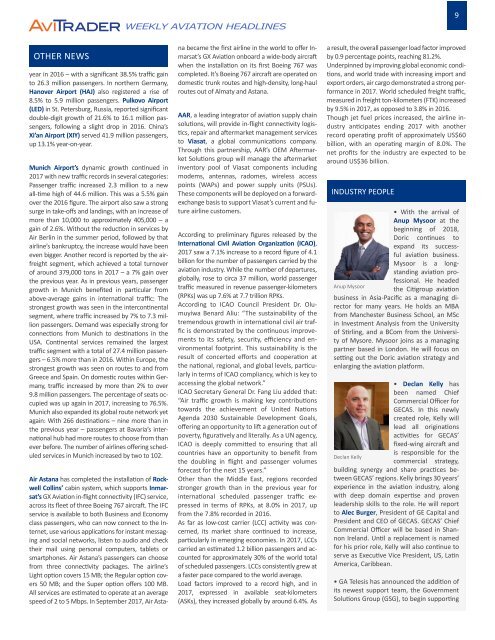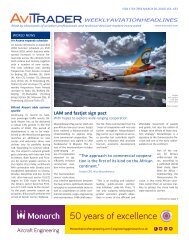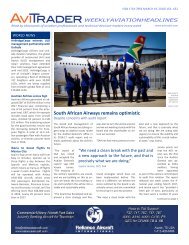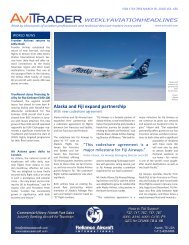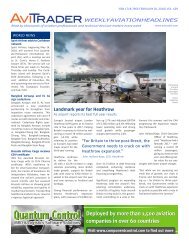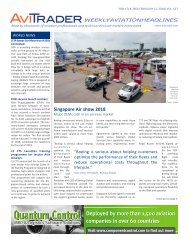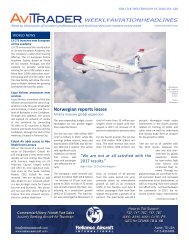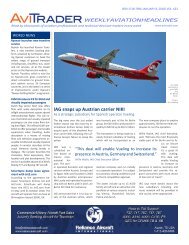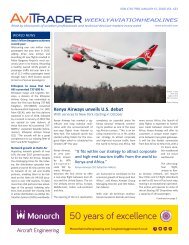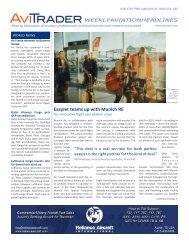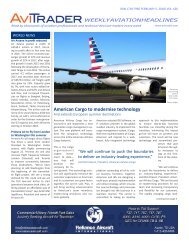You also want an ePaper? Increase the reach of your titles
YUMPU automatically turns print PDFs into web optimized ePapers that Google loves.
WEEKLY AVIATION HEADLINES<br />
9<br />
OTHER NEWS<br />
year in 2<strong>01</strong>6 – with a significant 38.5% traffic gain<br />
to 26.3 million passengers. In northern Germany,<br />
Hanover Airport (HAJ) also registered a rise of<br />
8.5% to 5.9 million passengers. Pulkovo Airport<br />
(LED) in St. Petersburg, Russia, reported significant<br />
double-digit growth of 21.6% to 16.1 million passengers,<br />
following a slight drop in 2<strong>01</strong>6. China’s<br />
Xi’an Airport (XIY) served 41.9 million passengers,<br />
up 13.1% year-on-year.<br />
Munich Airport’s dynamic growth continued in<br />
2<strong>01</strong>7 with new traffic records in several categories:<br />
Passenger traffic increased 2.3 million to a new<br />
all-time high of 44.6 million. This was a 5.5% gain<br />
over the 2<strong>01</strong>6 figure. The airport also saw a strong<br />
surge in take-offs and landings, with an increase of<br />
more than 10,000 to approximately 405,000 – a<br />
gain of 2.6%. Without the reduction in services by<br />
Air Berlin in the summer period, followed by that<br />
airline’s bankruptcy, the increase would have been<br />
even bigger. Another record is reported by the airfreight<br />
segment, which achieved a total turnover<br />
of around 379,000 tons in 2<strong>01</strong>7 – a 7% gain over<br />
the previous year. As in previous years, passenger<br />
growth in Munich benefited in particular from<br />
above-average gains in international traffic: The<br />
strongest growth was seen in the intercontinental<br />
segment, where traffic increased by 7% to 7.3 million<br />
passengers. Demand was especially strong for<br />
connections from Munich to destinations in the<br />
USA. Continental services remained the largest<br />
traffic segment with a total of 27.4 million passengers<br />
– 6.5% more than in 2<strong>01</strong>6. Within Europe, the<br />
strongest growth was seen on routes to and from<br />
Greece and Spain. On domestic routes within Germany,<br />
traffic increased by more than 2% to over<br />
9.8 million passengers. The percentage of seats occupied<br />
was up again in 2<strong>01</strong>7, increasing to 76.5%.<br />
Munich also expanded its global route network yet<br />
again: With 266 destinations – nine more than in<br />
the previous year – passengers at Bavaria’s international<br />
hub had more routes to choose from than<br />
ever before. The number of airlines offering scheduled<br />
services in Munich increased by two to 102.<br />
Air Astana has completed the installation of Rockwell<br />
Collins’ cabin system, which supports Inmarsat’s<br />
GX Aviation in-flight connectivity (IFC) service,<br />
across its fleet of three Boeing 767 aircraft. The IFC<br />
service is available to both Business and Economy<br />
class passengers, who can now connect to the Internet,<br />
use various applications for instant messaging<br />
and social networks, listen to audio and check<br />
their mail using personal computers, tablets or<br />
smartphones. Air Astana’s passengers can choose<br />
from three connectivity packages. The airline’s<br />
Light option covers 15 MB; the Regular option covers<br />
50 MB; and the Super option offers 100 MB.<br />
All services are estimated to operate at an average<br />
speed of 2 to 5 Mbps. In September 2<strong>01</strong>7, Air Astana<br />
became the first airline in the world to offer Inmarsat’s<br />
GX Aviation onboard a wide-body aircraft<br />
when the installation on its first Boeing 767 was<br />
completed. It’s Boeing 767 aircraft are operated on<br />
domestic trunk routes and high-density, long-haul<br />
routes out of Almaty and Astana.<br />
AAR, a leading integrator of aviation supply chain<br />
solutions, will provide in-flight connectivity logistics,<br />
repair and aftermarket management services<br />
to Viasat, a global communications company.<br />
Through this partnership, AAR’s OEM Aftermarket<br />
Solutions group will manage the aftermarket<br />
inventory pool of Viasat components including<br />
modems, antennas, radomes, wireless access<br />
points (WAPs) and power supply units (PSUs).<br />
These components will be deployed on a forwardexchange<br />
basis to support Viasat’s current and future<br />
airline customers.<br />
According to preliminary figures released by the<br />
International Civil Aviation Organization (ICAO),<br />
2<strong>01</strong>7 saw a 7.1% increase to a record figure of 4.1<br />
billion for the number of passengers carried by the<br />
aviation industry. While the number of departures,<br />
globally, rose to circa 37 million, world passenger<br />
traffic measured in revenue passenger-kilometers<br />
(RPKs) was up 7.6% at 7.7 trillion RPKs.<br />
According to ICAO Council President Dr. Olumuyiwa<br />
Benard Aliu: “The sustainability of the<br />
tremendous growth in international civil air traffic<br />
is demonstrated by the continuous improvements<br />
to its safety, security, efficiency and environmental<br />
footprint. This sustainability is the<br />
result of concerted efforts and cooperation at<br />
the national, regional, and global levels, particularly<br />
in terms of ICAO compliancy, which is key to<br />
accessing the global network.”<br />
ICAO Secretary General Dr. Fang Liu added that:<br />
“Air traffic growth is making key contributions<br />
towards the achievement of United Nations<br />
Agenda 2030 Sustainable Development Goals,<br />
offering an opportunity to lift a generation out of<br />
poverty, figuratively and literally. As a UN agency,<br />
ICAO is deeply committed to ensuring that all<br />
countries have an opportunity to benefit from<br />
the doubling in flight and passenger volumes<br />
forecast for the next 15 years.”<br />
Other than the Middle East, regions recorded<br />
stronger growth than in the previous year for<br />
international scheduled passenger traffic expressed<br />
in terms of RPKs, at 8.0% in 2<strong>01</strong>7, up<br />
from the 7.8% recorded in 2<strong>01</strong>6.<br />
As far as low-cost carrier (LCC) activity was concerned,<br />
its market share continued to increase,<br />
particularly in emerging economies. In 2<strong>01</strong>7, LCCs<br />
carried an estimated 1.2 billion passengers and accounted<br />
for approximately 30% of the world total<br />
of scheduled passengers. LCCs consistently grew at<br />
a faster pace compared to the world average.<br />
Load factors improved to a record high, and in<br />
2<strong>01</strong>7, expressed in available seat-kilometers<br />
(ASKs), they increased globally by around 6.4%. As<br />
a result, the overall passenger load factor improved<br />
by 0.9 percentage points, reaching 81.2%.<br />
Underpinned by improving global economic conditions,<br />
and world trade with increasing import and<br />
export orders, air cargo demonstrated a strong performance<br />
in 2<strong>01</strong>7. World scheduled freight traffic,<br />
measured in freight ton-kilometers (FTK) increased<br />
by 9.5% in 2<strong>01</strong>7, as opposed to 3.8% in 2<strong>01</strong>6.<br />
Though jet fuel prices increased, the airline industry<br />
anticipates ending 2<strong>01</strong>7 with another<br />
record operating profit of approximately US$60<br />
billion, with an operating margin of 8.0%. The<br />
net profits for the industry are expected to be<br />
around US$36 billion.<br />
INDUSTRY PEOPLE<br />
• With the arrival of<br />
Anup Mysoor at the<br />
beginning of <strong>2<strong>01</strong>8</strong>,<br />
Doric continues to<br />
expand its successful<br />
aviation business.<br />
Mysoor is a longstanding<br />
aviation professional.<br />
He headed<br />
Anup Mysoor<br />
the Citigroup aviation<br />
business in Asia-Pacific as a managing director<br />
for many years. He holds an MBA<br />
from Manchester Business School, an MSc<br />
in Investment Analysis from the University<br />
of Stirling, and a BCom from the University<br />
of Mysore. Mysoor joins as a managing<br />
partner based in London. He will focus on<br />
setting out the Doric aviation strategy and<br />
enlarging the aviation platform.<br />
• Declan Kelly has<br />
been named Chief<br />
Commercial Officer for<br />
GECAS. In this newly<br />
created role, Kelly will<br />
lead all originations<br />
activities for GECAS’<br />
fixed-wing aircraft and<br />
is responsible for the<br />
Declan Kelly<br />
commercial strategy,<br />
building synergy and share practices between<br />
GECAS’ regions. Kelly brings 30 years’<br />
experience in the aviation industry, along<br />
with deep domain expertise and proven<br />
leadership skills to the role. He will report<br />
to Alec Burger, President of GE Capital and<br />
President and CEO of GECAS. GECAS’ Chief<br />
Commercial Officer will be based in Shannon<br />
Ireland. Until a replacement is named<br />
for his prior role, Kelly will also continue to<br />
serve as Executive Vice President, US, Latin<br />
America, Caribbean.<br />
• GA Telesis has announced the addition of<br />
its newest support team, the Government<br />
Solutions Group (GSG), to begin supporting


